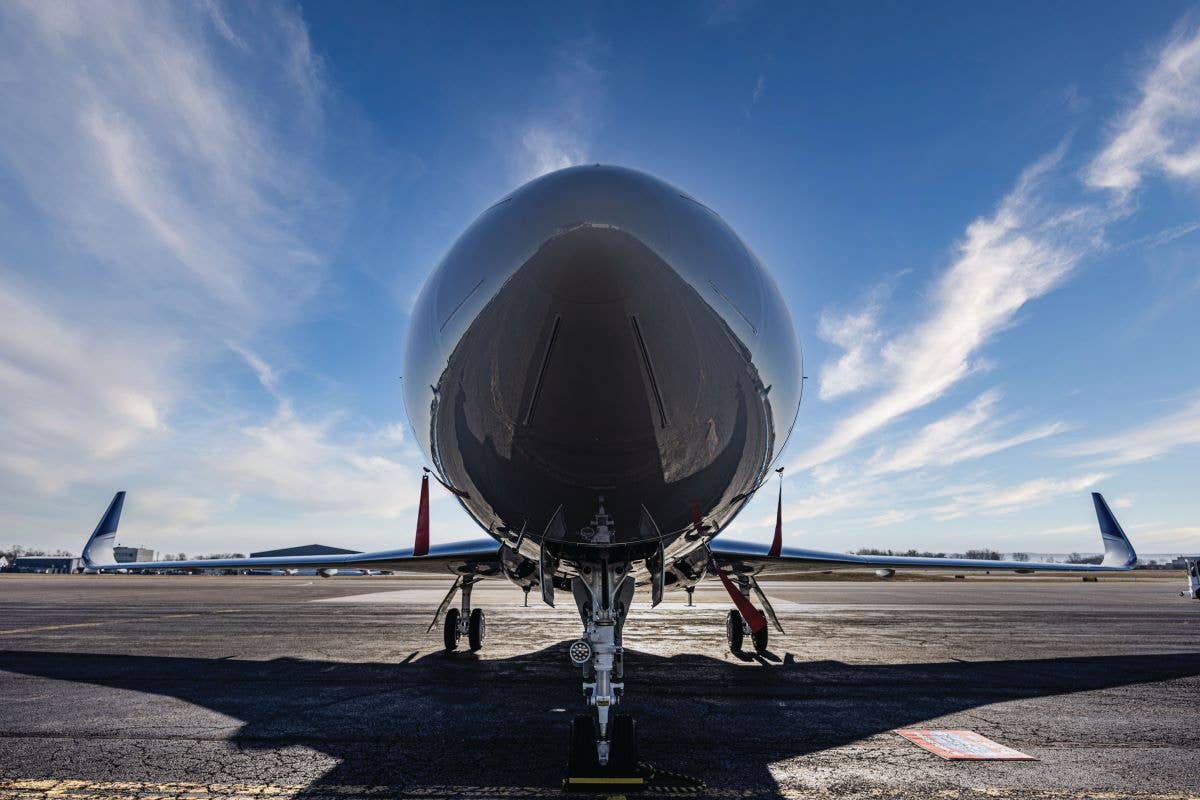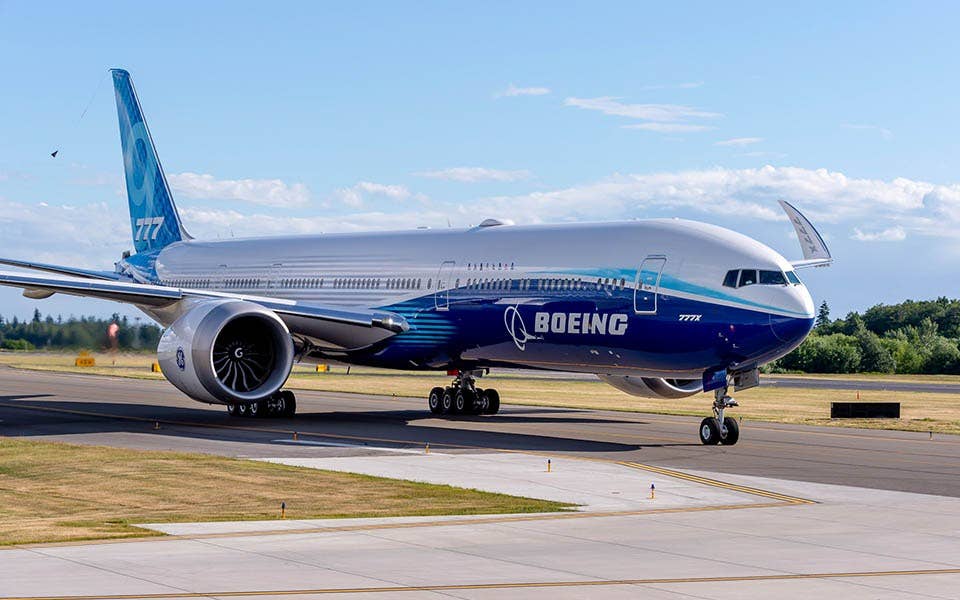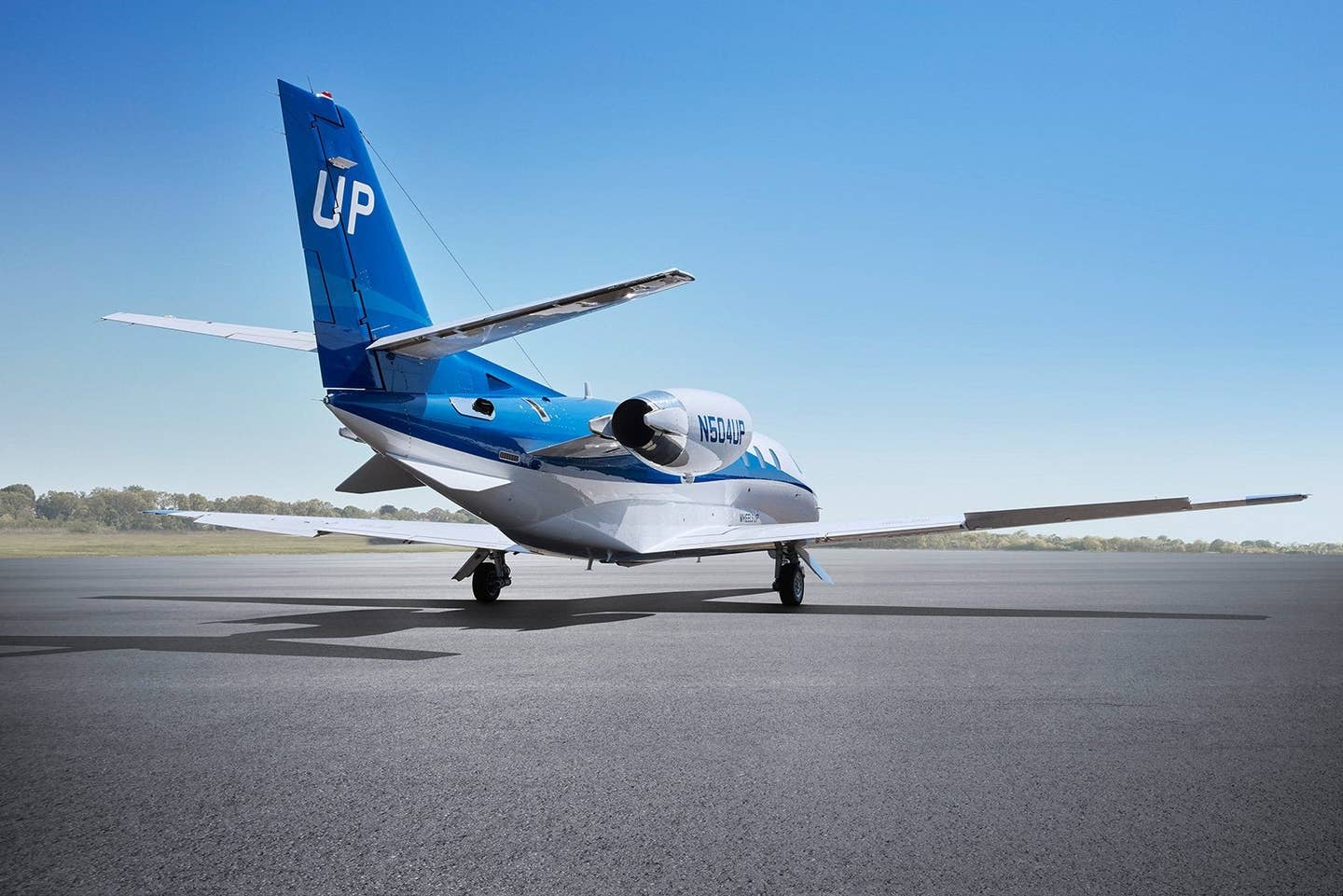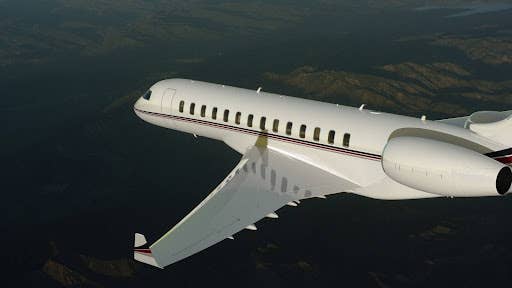Large Cabin Chasm
A gap in the 4,000 to 6,000 nm range prompts the question: Who will take advantage of this sweet spot?

[Credit: Stephen Yeates]
Editor's note: This article was originally published in the April 2023 issue of Business AIR.
There are 30 purpose-built business jet models in current production, starting with $4.5 million, 1,000-nm-range light turbofan airplanes, all the way up to $85 million-plus, 8,000 nm-plus uber cruisers. Add in the $100 to $200 million air yachts from Airbus and Boeing, and the total count jumps to 36. The sheer number of these machines, along with notable differences in cabin comfort, speed, range, airport performance, and fuel economy, suggest there’s a perfect fit for every customer.
In reality, though, some segments have considerable overlap, while others are sparsely populated. There’s a long-term trend, for instance, by private jet manufacturers to migrate upmarket, expanding their product portfolios to include bigger, faster, and farther-flying airplanes. They’ve been moving up from 1,000-to 1,500-nm-range light jets into 1,500- to 2,000-nm mid-size business aircraft, then migrating from mid-size into 3,000-nm-plus super-midsize jets. Embraer, with its Praetor 500 and 600 jets, and Textron Aviation, with the Citation Latitude and Longitude, are two OEMs that have recently moved upmarket into super-midsize.
This has created hot competition in the super-midsize jet class. The super-mids were originally envisioned three decades ago as more economical alternatives to fuel-thirsty trans-continental-range Lockheed JetStars and Gulfstream GIIs.
Upmarket Climbs
The trend began in the early 1990s, when Israel Aircraft Industries (IAI) started design work on the first super-midsize jet, the Astra IV—an evolution of the IAI 1125 Astra light jet onto which IAI grafted a much larger-diameter fuselage. The Astra IV, indeed, was almost the same diameter as a GII. But the program was chronically underfunded, delaying development for several years.
A few years later, the Astra IV was branded as the Galaxy when the Pritzker organization infused money into its development. Gulfstream bought into the program in 2001, and the Galaxy was eventually rebranded as the G200.
Despite the Astra IV/Galaxy/G200 being the first in this class, its ongoing development woes, including several increases in girth, enabled Bombardier to seize the sales lead with its Challenger 300 (née Continental) in 2003. Learning lessons from Gulfstream, Bombardier endowed the Challenger 300 with a big wing and big engines, thus providing margins for weight gain.
Gulfstream, however, wasn’t about to cede the super-mid segment to Bombardier. Capitalizing on its partnership with IAI, it completely transformed the G200 into the G280 in 2012. The revamped aircraft has a considerably longer cabin, a new larger and higher-speed wing that holds more fuel, more powerful engines, a characteristic Gulfstream T-tail, and a fresh aircraft type certificate. But Bombardier’s nine-year lead enabled it to cement its position as the mid-size class leader. It now owns the largest share of this market with the Challenger 300, along with its updated, more capable, and more comfortable Challenger 350 and 3500 models.
Embraer’s Praetor 500 and 600, Textron’s Latitude and Longitude, and the G280 now vie for the rest of the pie. All the super-mids have two-section cabins, mostly with four chairs in club configuration in the forward and aft seating areas, accommodating eight passengers. Some models offer two-facing chairs and a three-place side-facing divan in the aft cabin in lieu of the four-chair club section. A few have four club chairs up front and six narrower chairs in the aft cabin.
These $20- to $30-million aircraft offer comfortable trans-continental U.S. range for 8 to 10 passengers. The newest versions can fly 3,400 nm to 3,900 nm, enabling them to cross oceans, as well. The longest-range models can fly Paris-to-New York non-stop missions that once were the exclusive province of spacious, large-cabin aircraft, with three seating sections providing ample passenger comfort for international flights. In contrast, a 9-hour trans-Atlantic trip in a two-section super-mid can be a physical endurance event for passengers.
The uppermost end of the private jet market is becoming increasingly crowded as business aviation’s three top titans, Bombardier, Dassault, and Gulfstream vie for building the biggest, fastest, and farthest-flying models, proportionately priced at $70 to $85 million.
The ultra-jet race started in 2008 when Gulfstream launched the 7,000-nm G650—larger, faster, and farther-flying than its predecessor, the G550. The G650 also cruised nearly 30 knots faster and 500 nm farther, plus it offered superior fuel efficiency at Mach 0.85 compared to the G550.
Speed Sells
When the G650 entered service in 2012, Gulfstream had racked up nearly 500 orders. Two years later, Gulfstream introduced the G650ER, featuring increased fuel capacity delivering 7,500 nm of range. Speed sells.
Bombardier countered the G650/G650ER in 2016 by introducing an even larger flagship, the 7,400-nm-range Global 7000, the largest purpose-built business aircraft ever launched. This giant offered a four-section cabin in place of the G650’s three-section cabin. Not to be outdone, Gulfstream countered by announcing the 7,500-nm-range G700, a stretched version of the G650 with four seating sections, plus a lower drag wing, more fuel-efficient engines, active sidestick controls, and an updated interior.
Bombardier’s Global 7000 proved to have 300 nm greater range than expected, so Montreal renamed it the Global 7500, and then launched the Global 8000,a close derivative with more fuel capacity, thereby increasing its range to 8,000 nm.
Gulfstream parried Bombardier’s Global 8000 thrust by creating the 8,000-nm-range G800, are placement for G650 that incorporates all the G700’s technical improvements to boost range by 500 nm. However, it retains the G650’s three-section cabin.
Dassault remained conspicuously absent from this end of the market for more than a decade. Then, in mid-2021, it officially launched the Mach 0.85-cruise, 7,500-nm-range Falcon 10X, claiming the distinction of having the biggest cabin in the class, which is considerably larger in volume than either the Gulfstream G700 or Bombardier Global 7500/8000. It’s the first Falcon to be powered by Rolls-Royce engines, the first to sport a T-tail, and the first Falcon flagship in more than four decades to have two engines—not three.
The top-most jets in this class can cruise 8,000 nm, enabling them to fly from Singapore to San Diego, Boston to Bangkok, or Prestwick to Perth. Push up the speed to Mach 0.90, and some will still fly 7,000 nm, making city pairs such as Toronto to Taipei, Buenos Aires to Brisbane, or Jacksonville to Johannesburg, to be flown in less than 14 hours.
But how frequently will passengers use these aircraft for 14-hour—let alone 15.5- to 16.5-hour—trips? The average mission length for this class of aircraft is about three hours—1,300 to 1,400 nm. That isn’t stopping Bombardier, Dassault, and Gulfstream, however, from betting billions on these flagships. A sizable number of customers will likely be ultra-high-net-worth individuals, billionaires seeking the most exclusive, bespoke air yachts, more for country club bragging rights than pure air transportation needs.
Enter the Gap
This upmarket thrust by Bombardier, Dassault, and Gulfstream is creating a noticeable gap in entry-level large-cabin business aircraft, ones with 4,000- to 6,000-nm range. Currently, there are seven players in this field: the Bombardier Challenger 650 and Global 5500, Dassault Falcon 2000LXS, Falcon 900LX and Falcon 6X, and Gulfstream G400 and G500. Each offers some features buyers expect in a 21st-century large-cabin aircraft. None offer them all.
Each of the seven models merits a close look to identify its strong points and disadvantages. Dig deeply into the numbers, and the size of the large cabin chasm becomes quite apparent.
The senior citizen of this class is the Bombardier Challenger 650. It’s grandfathered onto the original 1980 Challenger 600 FAA type certificate. It’s the least expensive large-cabin aircraft, but it offers the widest cabin, measuring almost eight feet wide at elbow height and nearly seven feet wide at the floor. It’s six feet high in the center, so this is one of the most comfortable large-cabin aircraft, at least among those with only two seating sections.
The 650’s floor plan most commonly has a four-chair forward club section and an aft four-seat conference grouping flanked by a three- or four-seat divan on the opposite side. Virtually all aircraft are completed with a forward galley ahead of the main two-section seating area, and a single aft lavatory with a rear door that provides inflight access to the aft baggage compartment. There isn’t a second forward lavatory for the crew.
The Challenger 650 is the fifth iteration of the legacy design, featuring larger cabin windows, updated avionics, and plusher interior furnishings. It makes the grade as a long-range large-cabin aircraft because you can squeeze out 4,000-nm legs, but only if you’re willing to slow down to Mach 0.74 (425 knots) average cruise speed. A 4,000-nm trip takes 9 hours, 30 minutes aboard this aircraft.
Push the Challenger 650 up to Mach 0.80, and its range drops to 3,700 nm, smack in the middle of the current generation of super-mids. Climb performance isn’t something Challenger 650 operators brag about, either. When departing at maximum takeoff weight, it’ll only reach 37,000 feet on initial climb. It’s also limited to a 41,000-foot ceiling, so you’re stuck in the organized track systems with Boeings and ‘Buses most of the time when crossing oceans. Plus, the cabin altitude at FL 410 is nearly 7,000 feet. The Challenger 650’s comparatively high wing loading, lack of leading edge high-lift devices, and 30-year-old engine technology also result in relatively long runway requirements, particularly when departing from high-density-altitude airports.
Performance Gains
The Dassault Falcon 2000LXS, in contrast, offers sprightly airport performance because of its full-span leading-edge slats, blended winglets, high-lift flaps, and sporty 7,000-lb.-thrust Pratt & Whitney Canada engines. It’s the fuel-efficiency leader in the large-cabin class because of its comparatively lightweight airframe and fine-tuned aerodynamics. It too, has a two-section cabin that is slightly longer, but a few inches narrower than the Challenger 650’s. Typical floor plans feature a forward, four-chair club section, and an aft four-seat conference grouping with two facing chairs on the opposite side. There is a forward galley and aft lavatory. As with the Challenger, there is no forward crew lavatory.
The Falcon 2000LXS will fly 4,000 nm with six passengers while cruising at Mach 0.80, according to Dassault. But its actual average cruise speed, as shown by the accompanying chart, is 430 ktas. Plan on 9 hours, 18 minutes for such trips. This aircraft can fly as high as 47,000 feet. The 9.3-psi pressurization system provides a maximum cabin altitude of 7,200 ft. at that altitude.
Spoiler alert: Gulfstream G400 arrives in less than two years. The smallest member of the GVII family is designed for a long-range cruise speed of Mach 0.85 because of its highly swept, super-critical wing, powerful engines, and high-altitude cruise capability. Its maximum range is 4,200 nm. We predict an average cruise speed of 481 ktas, so it will shave an hour off of a 4,000-nm trip compared to the Challenger 650 orFalcon 2000LXS. Its cabin cross section is very close to that of the Falcon 2000LXS, but it’s considerably longer, making room for 2½ seating sections, thus providing seating for up to 12 passengers. Each seating section is longer than either the Challenger 650 orFalcon 2000LXS, yielding more legroom for each passenger.
If buyers opt for shorter, two-section cabins, it makes space available up front for an optional forward crew lav. All models are equipped with a forward galley and aft lavatory. These aircraft have the highest pressurization in the class, thus cabin altitude never exceeds 4,850 ft., even at the 51,000-ft. Maximum cruising altitude. As a bonus, the G400 is the only entry-level large-cabin to boast fly-by-wire flight controls. This aircraft promises to bruise sales of both the Challenger 650 and Falcon 2000LXS.
Next up in Dassault’s product line is the Falcon 900LX, a distant derivative of the 1979 Falcon 50 trijet. It shares its fuselage cross section with the Falcon 2000LXS, but its main cabin is 6 feet 5 inches longer, sufficient for three comparatively short seating areas. Many aircraft have both forward crew and aft passenger lavatories, a welcome feature on long trips. All current production aircraft have forward galleys. Maximum cabin altitude is similar to that of the Falcon 2000LXS.
The Falcon 900LX shares its wing contours with the Falcon 2000LXS, along with full-span slats and high-lift flaps, providing excellent airport performance. But sharing the same wing aerodynamics also means its average cruise speed on the longest missions is only 420 ktas. A 4,650-nm trip takes slightly more than 11 hours.
Turn Up The Volume
The Bombardier Global 5500 is the heavyweight in this class, with the largest dimensions. It provides the second-largest cabin volume of any aircraft in this segment. The three-section cabin is typically configured with a four-chair club up front, a four-seat conference grouping on the left, an optional chaise on the right in the midsection, and a private stateroom in the aft section. Almost all aircraft have forward galleys and an aft lavatory, plus a second forward crew lavatory. The 10.3-psi pressurization system ensures cabin altitude never exceeds 5,700 feet.
The Global 5500 is a derivative of the Global 5000, a shortened version of the original 1998 Global Express. The newest model has upgraded Rolls-Royce engines with improved efficiency and a drag-reduction package that boosts its range to 6,000 nm. Powerful engines and full-span leading-edge slats endow it with excellent runway performance.
But shortening the Global Express didn’t save much weight. The Global 5500’s relatively ample girth hurts its fuel efficiency. It consumes 15 to 50 percent more fuel than other three-section large-cabin competitors. That’s damaging its popularity among large cabin jet buyers in today’s eco-conscious environment.
Gulfstream’s G500 is the closest competitor to the Global 5500. Its three-section cabin gives up 4 inches of maximum width, but all members of the GVII family have a non-circular cross-section that makes more room available at shoulder height for seated passengers. The main seating area is also slightly shorter than that of the Global 5500. Like other three-section, large-cabin aircraft, the G500’s interior is typically configured with a forward, four-chair club section, a four-seat conference area and credenza mid-cabin, and a private aft stateroom. All models have forward galleys and crew lavatories, plus an aft lavatory. GVII series aircraft—G400/G500/G600—have the highest pressurization in class with cabin altitude always remaining at or below 4,850 ft. And nothing in the sky has a quieter cabin. Those lower cabin altitudes and noise levels translate into lower fatigue on long-range missions—a critical factor in their long-term operational success.
Powerful engines and an impressively large wing give this aircraft runway performance on par with Global 5500, even though the Gulfstream lacks leading-edge slats. Fuel efficiency is the best of any three-section large-cabin aircraft that cruises at Mach 0.85. Similarly to the G400, the G500 has fly-by-wire flight controls.
Next One Up?
If cabin comfort is your top priority, nothing can touch the new Falcon 6X. This aircraft has the largest cross-section of any current-production, purpose-built business aircraft, netting an 8-foot wide and 6-foot, 4-inch high interior, according to our tape measure. The cabin is also virtually the same length as either the Global 5500 or Gulfstream G500. Thirty windows, each the largest of any Falcon yet built, flood the three-section cabin with bright ambient light. The main seating area has the typical four-chair club section up front, a four-seat conference area and a credenza in mid-cabin, and aft stateroom. All floor plans include a forward galley, crew lav, and an aft main passenger lavatory. There’s even a skylight in the ceiling above the galley.
The 10.2-psi pressurization system ensures cabin altitude never exceeds 6,000 feet. The Falcon 6X will likely cruise in the low forties, so actual cabin altitudes will range from 3,500 to 4,800 feet. Dassault also has made sizable reductions in cabin sound levels in recent years. The goal is to beat Gulfstream for quietest cabin honors. Plan on mid-40 dBA interior noise levels when this aircraft enters service later this year.
The Falcon 6X also vies for having the most advanced aviation technologies. Borrowing heavily from Dassault’s Mach 2 class Rafale strike fighter, the firm pioneered fly-by-wire flight controls in business aircraft with the Falcon 7X in 2007, and has been enhancing its digital flight control systems ever since. This makes the Falcon 6X feel as agile as the Falcon 10, based on our experience flying it. Even more important to both pilots and passengers, there are dozens of subtle enhancements that reduce flight-crew workload, improve situational awareness, and make the aircraft one of the safest ever designed. Note to pilots: This aircraft consistently touches down on the pavement as though it’s nestling into a feather bed.
The tradeoff for the Falcon 6X’s class-leading cabin comfort is comparatively modest performance. The Falcon 6X is a redux of the ill-fated Falcon 5X that was doomed by the development failure of its planned Snecma Silvercrest turbofan engines. When Dassault halted the Falcon 5X program, it elected to re-engine the Falcon 5X with well-proven Pratt & Whitney PW800-series engines while stretching the fuselage and adding fuel capacity. But the wing area remains the same while weight increases by nearly four tons. This results in the highest wing loading of any large-cabin business jet. That doesn’t help high-altitude climb and cruise performance.
The Falcon 5X also was designed when large-cabin business aircraft mostly flew at Mach 0.80, so Dassault mapped out the wing shape and sweep accordingly. At that speed, the Falcon 6X has a 5,500-nm maximum range. Push up the speed to Mach 0.85, and its range drops to 5,100 nm.
Cruising at Mach 0.80, the Falcon 6X’s fuel efficiency is better than the Global 5500’s, but not as economical as the G500. Cruising at Mach 0.85, the Falcon 6X’s fuel consumption is on par with the Global 5500.
Wing loading also has an impact on runway performance. While the Falcon 6X has one of the best high-lift systems, high wing loading results in the longest takeoff field lengths among direct competitors.
What Does the Market Want?
Perusing the strengths and compromises of this septet reveals the need for a clean-sheet design that offers the best qualities of each of the seven competitors. First, there’s no such thing as too large a cabin. Best-in-class 5,500-nm to 6,000-nm large-cabin jets, such as the Global 5500 and Falcon 6X, have 1,800- to 1,900-cubic-foot cabins by volume. That’s a good start, but that’s still one-third smaller than the four-section-cabin uber jets. Pairs of facing chairs typically convert into lay-flat berths, so three-section aircraft usually comfortably sleep no more than six people. Four-section cabins berth eight sleepers.
Buyers also want pressurized cabin altitude slower than 5,000 ft., and sound levels in the low-to mid-40 dBA range. They want forward and aft lavatories, galleys that can hold four to five full meals, and aft staterooms that afford complete privacy. Future aircraft require a forward lav for the crew, a mid-cabin lav for most passengers, and a third en-suite lavatory adjoining the aft stateroom.
Connectivity is key. More than one large-cabin jet operator has scrubbed a trip because WiFi and high-speed internet access systemswere inoperative. People in this class of aircraft expect connectivity on par with homes and offices. Worldwide KA-band satcom with WiFi mobile phone calling is almost an iron-clad necessity. Emerging low-earth-orbit KU- and KA-band satcom networks promise to give market leader Viasat hot competition and lead to considerably lower subscription prices. Wideband satcom typically is a $750,000 to $1 million option. Most large-cabin-class operators consider it a necessity.
Cabin comfort, convenience, and connectivity notwithstanding, passengers also expect new 4,000-nm to 6,000-nm large-cabin aircraft to offer more speed. Cruising at Mach 0.80 suddenly seemed so 20th century when the Mach 0.85 G650 debuted a decade ago. Gulfstream anchored the Mach 0.85 cruise speed benchmark with the G400 and G500. New-model large-cabin buyers now expect to cruise at that speed and dash at Mach 0.90 without an excessive increase in fuel consumption. Cruising at Mach 0.90 can shave an hour or more off trans-oceanic trips.
And finally, new large cabin entrants must offer at least 15 percent better fuel economy. GE, Pratt & Whitney, and Rolls-Royce continue to squeeze at least 5 to 7 percent more efficiency out of each generation of new turbofan engines. This puts pressure on airframe designers to develop radically reduced-drag large-cabin airframes—especially as people want much larger three- or four-section cabins.
Large-cabin-jet design challenges will be daunting, considering that such aircraft will also routinely cruise at up to 90 percent of the speed of sound, yet still be able to operate from hundreds of general aviation airports. There’s no point in having an airplane that saves an hour of trans-oceanic trip time if the closest suitable airport is 90 minutes from your home or office.
All of this points to the need for a new generation of entry-level, large-cabin aircraft that combine the cabin comfort of the Falcon 6X and the Global 5500, the speed of the Gulfstream G400/G500, and the fuel efficiency of the Falcon 2000LXS. That’s a stratospheric stretch in capabilities, but one that could yield soaring sales in the large-cabin segment.

Subscribe to Our Newsletter
Get the latest FLYING stories delivered directly to your inbox






